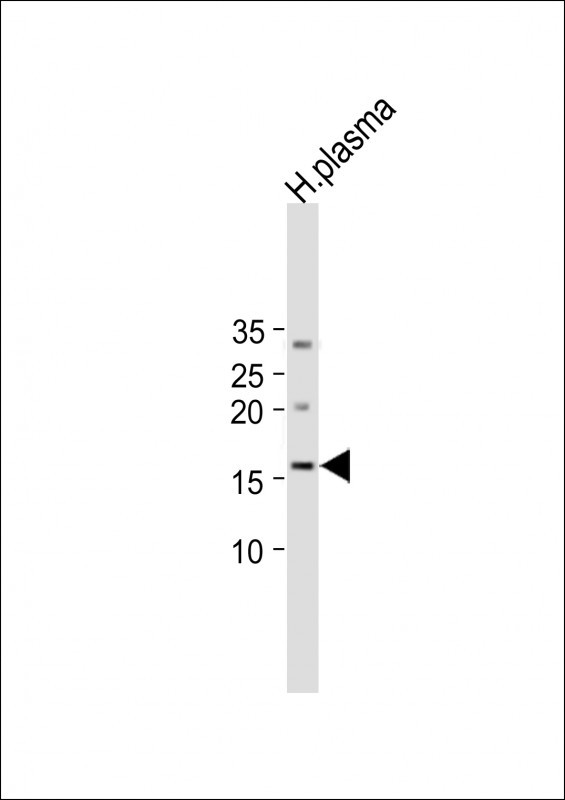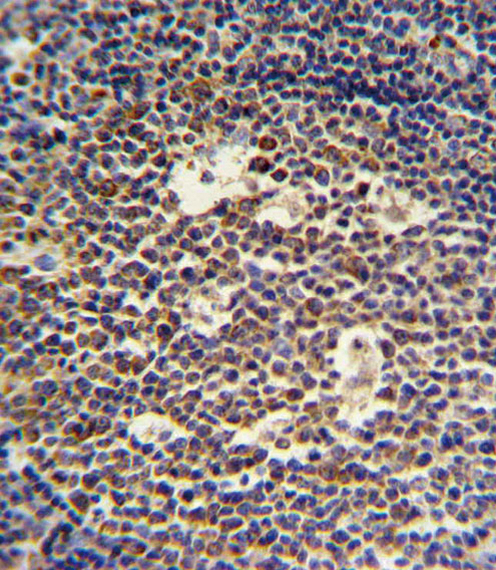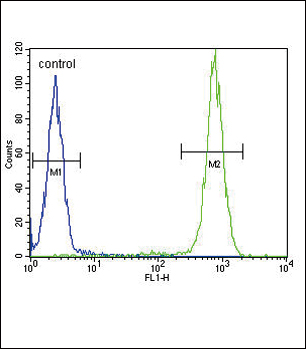IL4 Antibody (C-term)
Affinity Purified Rabbit Polyclonal Antibody (Pab)
- 产品详情
- 文献引用 : 2
- 实验流程
- 背景知识
Application
| WB, IHC-P, FC, E |
|---|---|
| Primary Accession | P05112 |
| Other Accession | P79339 |
| Reactivity | Human, Mouse |
| Predicted | Monkey |
| Host | Rabbit |
| Clonality | Polyclonal |
| Isotype | Rabbit IgG |
| Calculated MW | 17492 Da |
| Antigen Region | 122-151 aa |
| Gene ID | 3565 |
|---|---|
| Other Names | Interleukin-4, IL-4, B-cell stimulatory factor 1, BSF-1, Binetrakin, Lymphocyte stimulatory factor 1, Pitrakinra, IL4 |
| Target/Specificity | This L4 antibody is generated from rabbits immunized with a KLH conjugated synthetic peptide between 122-150 amino acids from the C-terminal region of human L4. |
| Dilution | WB~~1:500 IHC-P~~1:100~500 FC~~1:10~50 E~~Use at an assay dependent concentration. |
| Format | Purified polyclonal antibody supplied in PBS with 0.05% (V/V) Proclin 300. This antibody is prepared by Saturated Ammonium Sulfate (SAS) precipitation followed by dialysis against PBS. |
| Storage | Maintain refrigerated at 2-8°C for up to 2 weeks. For long term storage store at -20°C in small aliquots to prevent freeze-thaw cycles. |
| Precautions | IL4 Antibody (C-term) is for research use only and not for use in diagnostic or therapeutic procedures. |
| Name | IL4 |
|---|---|
| Function | Cytokine secreted primarily by mast cells, T-cells, eosinophils, and basophils that plays a role in regulating antibody production, hematopoiesis and inflammation, and the development of effector T-cell responses (PubMed:1993171, PubMed:3016727). Induces the expression of class II MHC molecules on resting B-cells. Enhances both secretion and cell surface expression of IgE and IgG1 (PubMed:1993171). Also regulates the expression of the low affinity Fc receptor for IgE (CD23) on both lymphocytes and monocytes (PubMed:2521231). Positively regulates IL31RA expression in macrophages. Stimulates autophagy in dendritic cells by interfering with mTORC1 signaling and through the induction of RUFY4. In addition, plays a critical role in higher functions of the normal brain, such as memory and learning (By similarity). Upon binding to IL4, IL4R receptor dimerizes either with the common IL2R gamma chain/IL2RG to produce the type 1 signaling complex, located mainly on hematopoietic cells, or with the IL13RA1 to produce the type 2 complex, which is also expressed on nonhematopoietic cells (PubMed:10219247, PubMed:11526337, PubMed:18243101). Engagement of both types of receptors initiates JAK3 and to a lower extend JAK1 phosphorylation leading to activation of the signal transducer and activator of transcription 6/STAT6 (PubMed:7721895). |
| Cellular Location | Secreted. |
For Research Use Only. Not For Use In Diagnostic Procedures.

Provided below are standard protocols that you may find useful for product applications.
BACKGROUND
IL4 is a pleiotropic cytokine produced by activated T cells. This cytokine is a ligand for interleukin 4 receptor. The interleukin 4 receptor also binds to IL13, which may contribute to many overlapping functions of this cytokine and IL13. STAT6, a signal transducer and activator of transcription, has been shown to play a central role in mediating the immune regulatory signal of this cytokine. This gene, IL3, IL5, IL13, and CSF2 form a cytokine gene cluster on chromosome 5q, with this gene particularly close to IL13. This gene, IL13 and IL5 are found to be regulated coordinately by several long-range regulatory elements in an over 120 kilobase range on the chromosome.
REFERENCES
Wong, H.L., et al. AIDS 24(7):1025-1033(2010) Davila, S., et al. Genes Immun. 11(3):232-238(2010) Trajkov, D., et al. Indian J Tuberc 56(3):117-131(2009)
终于等到您。ABCEPTA(百远生物)抗体产品。
点击下方“我要评价 ”按钮提交您的反馈信息,您的反馈和评价是我们最宝贵的财富之一,
我们将在1-3个工作日内处理您的反馈信息。
如有疑问,联系:0512-88856768 tech-china@abcepta.com.






















 癌症的基本特征包括细胞增殖、血管生成、迁移、凋亡逃避机制和细胞永生等。找到癌症发生过程中这些通路的关键标记物和对应的抗体用于检测至关重要。
癌症的基本特征包括细胞增殖、血管生成、迁移、凋亡逃避机制和细胞永生等。找到癌症发生过程中这些通路的关键标记物和对应的抗体用于检测至关重要。 为您推荐一个泛素化位点预测神器——泛素化分析工具,可以为您的蛋白的泛素化位点作出预测和评分。
为您推荐一个泛素化位点预测神器——泛素化分析工具,可以为您的蛋白的泛素化位点作出预测和评分。 细胞自噬受体图形绘图工具为你的蛋白的细胞受体结合位点作出预测和评分,识别结合到自噬通路中的蛋白是非常重要的,便于让我们理解自噬在正常生理、病理过程中的作用,如发育、细胞分化、神经退化性疾病、压力条件下、感染和癌症。
细胞自噬受体图形绘图工具为你的蛋白的细胞受体结合位点作出预测和评分,识别结合到自噬通路中的蛋白是非常重要的,便于让我们理解自噬在正常生理、病理过程中的作用,如发育、细胞分化、神经退化性疾病、压力条件下、感染和癌症。








